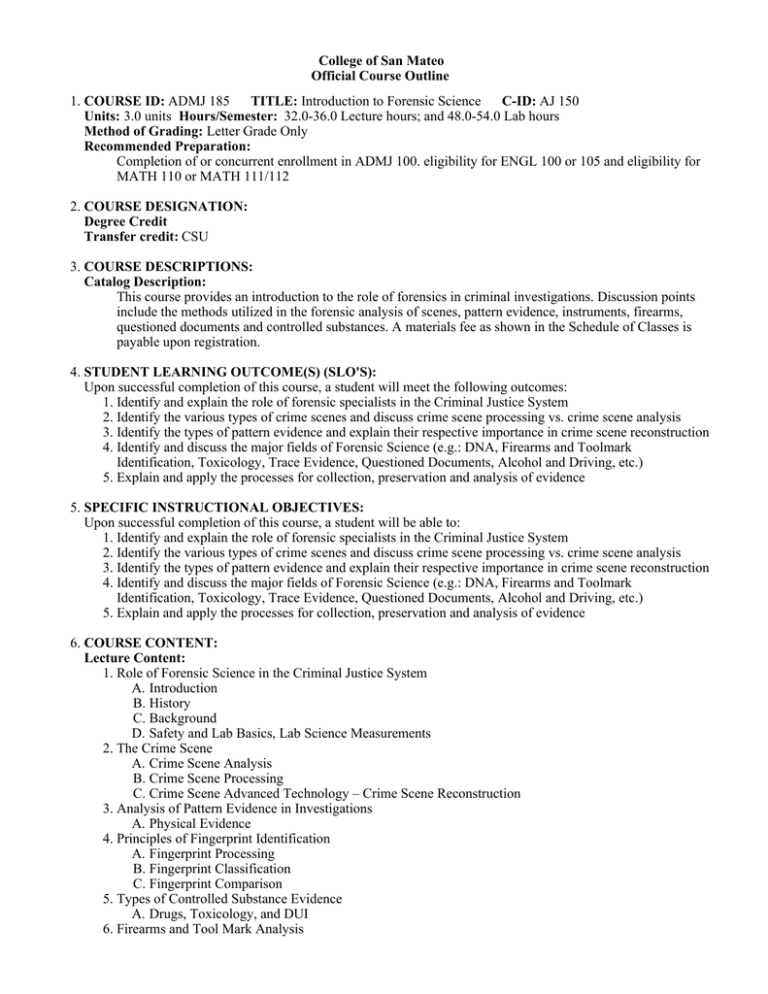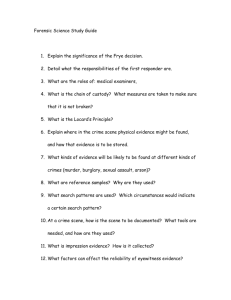College of San Mateo Official Course Outline COURSE ID: Units:
advertisement

College of San Mateo Official Course Outline 1. COURSE ID: ADMJ 185 TITLE: Introduction to Forensic Science C-ID: AJ 150 Units: 3.0 units Hours/Semester: 32.0-36.0 Lecture hours; and 48.0-54.0 Lab hours Method of Grading: Letter Grade Only Recommended Preparation: Completion of or concurrent enrollment in ADMJ 100. eligibility for ENGL 100 or 105 and eligibility for MATH 110 or MATH 111/112 2. COURSE DESIGNATION: Degree Credit Transfer credit: CSU 3. COURSE DESCRIPTIONS: Catalog Description: This course provides an introduction to the role of forensics in criminal investigations. Discussion points include the methods utilized in the forensic analysis of scenes, pattern evidence, instruments, firearms, questioned documents and controlled substances. A materials fee as shown in the Schedule of Classes is payable upon registration. 4. STUDENT LEARNING OUTCOME(S) (SLO'S): Upon successful completion of this course, a student will meet the following outcomes: 1. Identify and explain the role of forensic specialists in the Criminal Justice System 2. Identify the various types of crime scenes and discuss crime scene processing vs. crime scene analysis 3. Identify the types of pattern evidence and explain their respective importance in crime scene reconstruction 4. Identify and discuss the major fields of Forensic Science (e.g.: DNA, Firearms and Toolmark Identification, Toxicology, Trace Evidence, Questioned Documents, Alcohol and Driving, etc.) 5. Explain and apply the processes for collection, preservation and analysis of evidence 5. SPECIFIC INSTRUCTIONAL OBJECTIVES: Upon successful completion of this course, a student will be able to: 1. Identify and explain the role of forensic specialists in the Criminal Justice System 2. Identify the various types of crime scenes and discuss crime scene processing vs. crime scene analysis 3. Identify the types of pattern evidence and explain their respective importance in crime scene reconstruction 4. Identify and discuss the major fields of Forensic Science (e.g.: DNA, Firearms and Toolmark Identification, Toxicology, Trace Evidence, Questioned Documents, Alcohol and Driving, etc.) 5. Explain and apply the processes for collection, preservation and analysis of evidence 6. COURSE CONTENT: Lecture Content: 1. Role of Forensic Science in the Criminal Justice System A. Introduction B. History C. Background D. Safety and Lab Basics, Lab Science Measurements 2. The Crime Scene A. Crime Scene Analysis B. Crime Scene Processing C. Crime Scene Advanced Technology – Crime Scene Reconstruction 3. Analysis of Pattern Evidence in Investigations A. Physical Evidence 4. Principles of Fingerprint Identification A. Fingerprint Processing B. Fingerprint Classification C. Fingerprint Comparison 5. Types of Controlled Substance Evidence A. Drugs, Toxicology, and DUI 6. Firearms and Tool Mark Analysis A. Tool Marks and Firearms A. Tool Marks and Firearms 7. Analysis of Document Evidence A. Questioned Documents 8. Collection, Preservation and Analysis of DNA Evidence A. Blood Analysis-Serology B. Blood Analysis – DNA Lab Content: 1. Role of Forensic Science in the Criminal Justice System A. Safety and Lab Basics, Lab Science Measurements (Lab) 2. The Crime Scene A. Crime Scene Processing (Lab) B. Trace Evidence Experiment (Lab) 3. Analysis of Pattern Evidence in Investigations A. Experiment (Lab) 4. Principles of Fingerprint Identification A. Fingerprint Processing Experiment (Lab) B. Fingerprint Classification Practice (Lab) C. Fingerprint Comparison Practice (Lab) 5. Firearms and Tool Mark Analysis A. Firearm Experiment (Lab) 6. Analysis of Document Evidence A. Questioned Documents Experiment (Lab) 7. Collection, Preservation and Analysis of DNA Evidence A. Blood Experiment (Lab) B. Blood Analysis – DNA (Lab, Demo, Film) 8. Arson and Explosives Evidence A. Tour of San Mateo County Forensic Laboratory (Lab) 7. REPRESENTATIVE METHODS OF INSTRUCTION: Typical methods of instruction may include: A. Lecture B. Lab 8. REPRESENTATIVE ASSIGNMENTS Representative assignments in this course may include, but are not limited to the following: Reading Assignments: Reading assignments from the text Other Outside Assignments: Identify firearm used from bullet found Math problems relating to crime scene processing 9. REPRESENTATIVE METHODS OF EVALUATION Representative methods of evaluation may include: A. Class Participation B. Lab Activities C. Written examination 10. REPRESENTATIVE TEXT(S): Possible textbooks include: A. Saferstein, R.. Criminalistics - Introduction to Forensic Science, 10th ed. Prentice Hall, 2010 Origination Date: August 2011 Curriculum Committee Approval Date: November 2013 Effective Term: Fall 2014 Course Originator: Michelle Schneider




